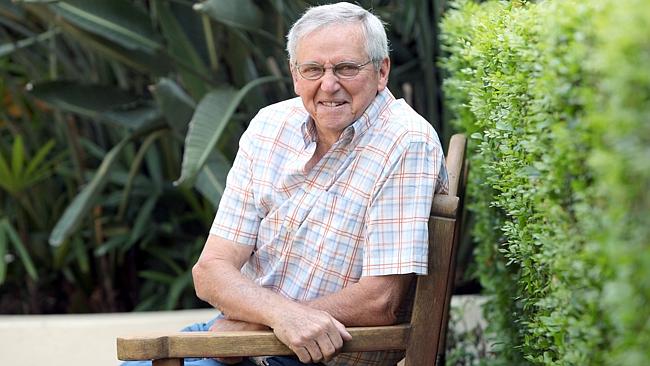THE Roy Emerson Tennis Centre at Milton will be opened on Thursday by the 78-year-old himself.
The man who boasts the most Grand Slam singles titles (12) of any Queenslander serves up from his home in Newport Beach, California ahead of his latest trip to Australia.
It took us in Queensland a long time to recognise you like this (the new centre on the site of the old Milton stadium).
Brisbane lost a lot of courts to real estate development over the years. It’s great there will be six more courts in Brisbane for kids to play on. When I lived in Brisbane, there were hundreds and hundreds of private courts and many of them have apartments on the land now. My dad had a home at the Grange at one stage and had three or four courts which all the kids used to play on, antbed courts. My wife Joy, her father used to have a court on Sandgate Road, just past Nundah.

The old Stefan tennis racquet which used to stand at the old Milton tennis stadium has been incorporated in the $12m Frew Park leisure development. Picture: Claudia Baxter
You played in two Challenge Round (now called a final) wins at Milton with the Australian Davis Cup team. What were your other great wins there?
I won an Australian championships there. I beat Arthur Ashe in a final. Milton was a good centre in the 1960s. There were a Challenge Round against Spain one year I remember (1967) and Mexico another (1962). I liked the grass courts at Milton. I met Joy at Milton too.
Two other country boys will be at the opening on Thursday, I’m told, Rod Laver and Mal Anderson. Bring back some memories?
Sure. Rod only lives 90 miles south of me in California and Mal is my brother-in-law.

Brisbane’s Milton Park during 1967 Davis Cup final between Roy Emerson & Manuel Santana.
What surface were the courts you hit on in Blackbutt, where you grew up?
Antbed. We knocked down antnests at the back of our property and built the court at the back of our house. We cut down some trees and put some chicken wire around the stumps left in the ground.
The tennis game you honed took you to a wonderful record, 12 Grand Slam singles titles and 16 doubles titles. In your Grand Slam singles finals, you played 15 and lost only three, all to Rod Laver and all in 1962, his first Grand Slam year.
I had a chance in the French against him but he eked it out after I led two sets to love. The other two were four sets. We always had a good scrap against each other. He was always tough over five sets. He was a pretty good player, Rocket.

Roy Emerson holds the Wimbledon trophy aloft after his win in 1965. Picture: Supplied
Then you won 10 Grand Slam titles in a row.
Yes, and before that in 1961 I beat Rod in the final of the Australian. You know the first time I saw myself on television, it was at Wimbledon in the 1950s. I thought, `What sort of game have you got?’ All the twitches I had.
Who was or is the best player of all time?
It’s not fair to say because you have to think about different eras and what the equipment was like. They hit the ball so hard compared to what we did with the smaller headed, wooden racquets. Tennis is such big business now. For winning Wimbledon in 1964, I got a trophy, my name added to the cup and each country was allocated a certain amount of money for players to play Wimbledon, so the Australian allotment for expenses might have been divided by 20.
Roger Federer at this stage is so consistent … (1938 Grand Slam winner Don) Budge, Laver, Pete Sampras, Novak Djokovic, it’s so hard to name one player.

Rod Laver after winning the US Open, where he beat Roy Emerson.
The Aussies (in your era) had such high standards for their tennis and they also had an irreverence and a sense of fun on tour.
When we played in the amateur days, you always had your heroes. Mine was Frank Sedgman and he was such a great sport and then along came (Lew) Hoad and (Ken) Rosewall. We had a lot of great champions to try to emulate. We wanted badly to beat each other in a match but we had a great camaraderie and a lot of respect for each other.
In the early 1990s, the Swiss named their main court at Gstaad the Roy Emerson Arena.
It is still there. It was quite a shock for that to happen in a foreign country and very much appreciated. I used to play the Swiss Open any time I could, the first time was in the late 1950s. I won the championship five times and when I started doing my tennis week at the Palace Hotel, that was in the early 1970s. This year will be the 42nd year I have been doing it. My son Anthony, who lives in Florida, works with me in Switzerland every (northern) summer.

Roger Federer relaxes after a match the Swiss Open in Gstaad.
You were there the day the Gstaad tournament presented Roger Federer with the first of the two cows they gave him.
That was the first time he’d won Wimbledon (in 2003) and then he played the Swiss Open next. That was a way to celebrate his win, with the presentation of a cow. He didn’t know what he was going to do with it, so I said you can put it in your garage back in Basel. He didn’t think that was a good idea, so the cow stayed at a chalet in the mountains and they sent him the cream and butter it produced.
What’s the most impressive thing about Federer?
He is a great ambassador for the game. We are fortunate he has been able to stay at the top for so many years when so many younger players play their best against him, because they have nothing to lose. He’s been in such great physical shape for so long and he’s a great sportsman.
There’s lot of enthusiasm for the Aussie teenagers, Nick Kyrgios and Thanasi Kokkinakis. Have you seen enough to have formed an opinion?
Not enough. I plan on doing it when I am in Australia. They seem to have huge games and talent, same as players from other countries. If they don’t work hard enough, they will be left behind. It’s up to them.
And Bernard Tomic at 22?
If he doesn’t work, he’s not going to make it. Simple as that. He’d be a very silly boy to not give himself the best chance by staying physically fit for five sets and then be good to go the next game.

